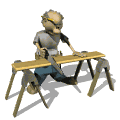TIMBA-WOLF
Board Moderator
     Offline
Offline

Timba-Wolf..... Var@*sh, should be banned!!
Posts: 7158
Total Thanks: 15For This Post: 0
 KENT,(under a tree!!!!) KENT,(under a tree!!!!)
United Kingdom
Gender: 
Trade: Joiner
|
Right firstly RAF, welcome to this here forum, and i hope you enjoy the help and advise, .. you have started off in the right way, by asking questions... after all we are here to help! , and remember...
"THE ONLY SILLY QUESTION IS THE ONE YOU DO NOT ASK!!"
Congrates on your 1st home!!!!
right business time....
Knotting/bleeding... when a piece of timber is new, and non painted, you will find the odd knot or two along its length... it is these knots that can sometimes, when left alone, and just painted straight over, "BLEED" resin, from them selves, which results in yellow marks and not fully dried paint where the knots are!! which is why when timber is new, the knots are normally painted over with something called KNOTTING SOLUTION!
as for the gloss work, "keying up" is an essential part of painting, as it offers a KEY to the surface, allowing the new paint to STICK to the old ... as is wiping over with sugar soap solution, to remove any greasy prints etc, as well as the dust left by the keying up!
if gritty /and or runs... then a fine sandpaper, to just take the mark/s out will be best......
for a full run down of the way to do it, i will try and get Cora, or Hammy, our resident Painters to pop in here and advise you better!!!
regards WOLF!
|